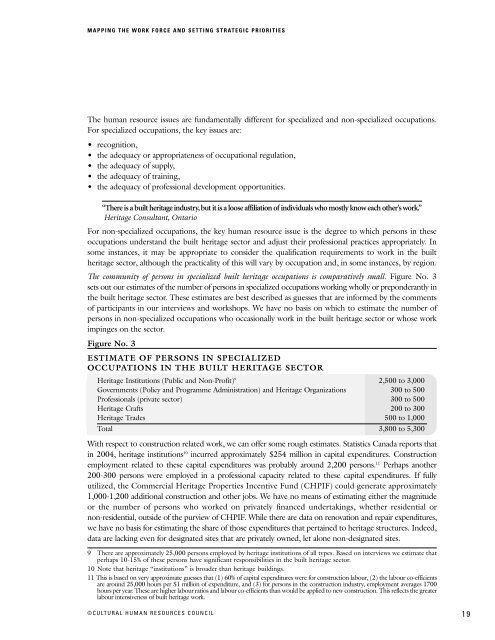Human Resources in Canada's Built Heritage Sector: Mapping the ...
Human Resources in Canada's Built Heritage Sector: Mapping the ...
Human Resources in Canada's Built Heritage Sector: Mapping the ...
- No tags were found...
You also want an ePaper? Increase the reach of your titles
YUMPU automatically turns print PDFs into web optimized ePapers that Google loves.
MAPPING THE WORK FORCE AND SETTING STRATEGIC PRIORITIESThe human resource issues are fundamentally different for specialized and non-specialized occupations.For specialized occupations, <strong>the</strong> key issues are:• recognition,• <strong>the</strong> adequacy or appropriateness of occupational regulation,• <strong>the</strong> adequacy of supply,• <strong>the</strong> adequacy of tra<strong>in</strong><strong>in</strong>g,• <strong>the</strong> adequacy of professional development opportunities.“There is a built heritage <strong>in</strong>dustry, but it is a loose affiliation of <strong>in</strong>dividuals who mostly know each o<strong>the</strong>r’s work.”<strong>Heritage</strong> Consultant, OntarioFor non-specialized occupations, <strong>the</strong> key human resource issue is <strong>the</strong> degree to which persons <strong>in</strong> <strong>the</strong>seoccupations understand <strong>the</strong> built heritage sector and adjust <strong>the</strong>ir professional practices appropriately. Insome <strong>in</strong>stances, it may be appropriate to consider <strong>the</strong> qualification requirements to work <strong>in</strong> <strong>the</strong> buil<strong>the</strong>ritage sector, although <strong>the</strong> practicality of this will vary by occupation and, <strong>in</strong> some <strong>in</strong>stances, by region.The community of persons <strong>in</strong> specialized built heritage occupations is comparatively small. Figure No. 3sets out our estimates of <strong>the</strong> number of persons <strong>in</strong> specialized occupations work<strong>in</strong>g wholly or preponderantly <strong>in</strong><strong>the</strong> built heritage sector. These estimates are best described as guesses that are <strong>in</strong>formed by <strong>the</strong> commentsof participants <strong>in</strong> our <strong>in</strong>terviews and workshops. We have no basis on which to estimate <strong>the</strong> number ofpersons <strong>in</strong> non-specialized occupations who occasionally work <strong>in</strong> <strong>the</strong> built heritage sector or whose workimp<strong>in</strong>ges on <strong>the</strong> sector.Figure No. 3ESTIMATE OF PERSONS IN SPECIALIZEDOCCUPATIONS IN THE BUILT HERITAGE SECTOR<strong>Heritage</strong> Institutions (Public and Non-Profit) 9 2,500 to 3,000Governments (Policy and Programme Adm<strong>in</strong>istration) and <strong>Heritage</strong> Organizations 300 to 500Professionals (private sector) 300 to 500<strong>Heritage</strong> Crafts 200 to 300<strong>Heritage</strong> Trades 500 to 1,000Total 3,800 to 5,300With respect to construction related work, we can offer some rough estimates. Statistics Canada reports that<strong>in</strong> 2004, heritage <strong>in</strong>stitutions 10 <strong>in</strong>curred approximately $254 million <strong>in</strong> capital expenditures. Constructionemployment related to <strong>the</strong>se capital expenditures was probably around 2,200 persons. 11 Perhaps ano<strong>the</strong>r200-300 persons were employed <strong>in</strong> a professional capacity related to <strong>the</strong>se capital expenditures. If fullyutilized, <strong>the</strong> Commercial <strong>Heritage</strong> Properties Incentive Fund (CHPIF) could generate approximately1,000-1,200 additional construction and o<strong>the</strong>r jobs. We have no means of estimat<strong>in</strong>g ei<strong>the</strong>r <strong>the</strong> magnitudeor <strong>the</strong> number of persons who worked on privately f<strong>in</strong>anced undertak<strong>in</strong>gs, whe<strong>the</strong>r residential ornon-residential, outside of <strong>the</strong> purview of CHPIF. While <strong>the</strong>re are data on renovation and repair expenditures,we have no basis for estimat<strong>in</strong>g <strong>the</strong> share of those expenditures that perta<strong>in</strong>ed to heritage structures. Indeed,data are lack<strong>in</strong>g even for designated sites that are privately owned, let alone non-designated sites.9 There are approximately 25,000 persons employed by heritage <strong>in</strong>stitutions of all types. Based on <strong>in</strong>terviews we estimate thatperhaps 10-15% of <strong>the</strong>se persons have significant responsibilities <strong>in</strong> <strong>the</strong> built heritage sector.10 Note that heritage “<strong>in</strong>stitutions” is broader than heritage build<strong>in</strong>gs.11 This is based on very approximate guesses that (1) 60% of capital expenditures were for construction labour, (2) <strong>the</strong> labour co-efficientsare around 25,000 hours per $1 million of expenditure, and (3) for persons <strong>in</strong> <strong>the</strong> construction <strong>in</strong>dustry, employment averages 1700hours per year. These are higher labour ratios and labour co-efficients than would be applied to new construction. This reflects <strong>the</strong> greaterlabour <strong>in</strong>tensiveness of built heritage work.©CULTURAL HUMAN RESOURCES COUNCIL19










